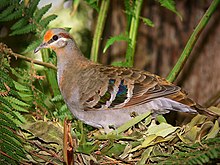Brush bronzewing
| Brush bronzewing | |
|---|---|
 |
|
| Scientific classification | |
| Kingdom: | Animalia |
| Phylum: | Chordata |
| Class: | Aves |
| Order: | Columbiformes |
| Family: | Columbidae |
| Genus: | Phaps |
| Species: | P. elegans |
| Binomial name | |
|
Phaps elegans (Temminck, 1810) |
|
 |
|
| Distribution of the brush bronzewing | |
The brush bronzewing (Phaps elegans) is a species of bird in the pigeon family, Columbidae. It is endemic to Australia, with two biogeographically distinct subspecies.
The brush bronzewing is one of around 310 species in the family Columbidae and can be classified into two distinct subspecies, P. elegans elegans and P. elegans occidentalis.P. elegans was first described by C. J. Temminck in 1810.
The brush bronzewing is similar in size and shape to the closely related common bronzewing (Phaps chalcoptera), however it's shorter and stockier in appearance.
These birds are relatively small and range in size from 25–33 cm.Sexual dimorphism is apparent in these birds. Both sexes are dark-olive brown on top, rich chestnut in colour along the nape and shoulder with blue-grey underparts. The brush bronzewing is named for the iridescent bars of blue and green across the inner secondary feather of each wing.
The brush bronzewing is endemic to Australia, found in the South-West and South-East of the mainland with populations in Queensland, New South Wales, Victoria, South Australia, Western Australia and also Tasmania. The subspecies P. elegans occidentalis occurs as a geographically distinct population, in the southwest of WA.
This species favours dense coastal heathland, wet or dry sclerophyll forests, woodlands and some mallee areas. Habitats with dense shrub layers and foliage, including native species such as Banksia, Acacia, Melaleuca or Leptospermum, allow these cautious birds to find cover.
This bird feeds on seeds, berries and small insects; foraging primarily on the ground Like most granivores, the brush bronzewing will swallow small pieces of grit and pebble to aid the grinding of seeds within the gizzard. Local movements are likely a response to food and habitat availability. Unlike the common bronzewing, feeding doesn't occur in small flocks, usually with birds foraging singly or in pairs. Also similarly to that species, the brush bronzewing drinks at dawn or dusk, approaching watering holes cautiously after landing a short distance away.
...
Wikipedia

